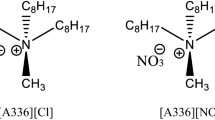Abstract
Extraction of thallium and indium, as the homologues of nihonium, from HCl solutions into hydrophobic ionic liquids was studied. In the presence of NaClO2 as the oxidizing agent, thallium is effectively extracted into all the tested ionic liquids from 0.2 to 5 M HCl. In absence of NaClO2, thallium extraction strongly depends on the HCl concentration and no extraction of indium was observed. Using [C6mim][NTf2] and [Tbma][NTf2], the thallium/indium separation factors SF(Tl/In) > 4 × 104 can be achieved. Hence, the system with NaClO2 oxidizing agent can be considered a candidate for the future studies of nihonium chemical properties.






Similar content being viewed by others
References
Aksenov NV et al (2017) On volatility of nihonium (Nh, Z = 113). Eur. Phys. J. 53:158
Eichler R (2013) First foot prints of chemistry on the shore of the Island of Superheavy Elements. J Phys: Conf Ser 420:012003
Bartl P, John J, Nemec M (2017) Advances in microfluidic technique - preparation for microfluidic liquid–liquid extraction of SHE homologues. Abstract Book. ISBN 978-91-88041-08-1
Karol PJ, Barber RC, Sherrill M, Vardaci E, Yamazaki T (2016) Discovery of the elements with atomic numbers Z = 113, 115 and 117. IUPAC Technical Report. Pure Appl Chem 88(1–2):139–153
Brookhaven National Laboratory, National Nuclear Data Center. Accessed October 9 2018 from http://www.nndc.bnl.gov
Fricke B (1975) Superheavy elements: a prediction of their physical and chemical properties. Recent Impact Phys Inorg Chem 21:89–144
Zaitsevskii A, van Wüllen C, Rusakov A, Titov A (2011) Relativistic DFT and ab initio calculations on the seventh-row superheavy elements: E113-E114. In: The 4th International conference on the chemistry and physics of the transactinide elements. Sochi, Russia
Keller OL Jr, Burnett JL, Carlson TA, Nestor CW Jr (1969) Predicted properties of the super heavy elements. I. Elements 113 and 114, eka-thallium and eka-lead. J Phys Chem 74(5):1127–1134
Greenwood N, Earnshaw A (1993) Chemistry of elements. Informatorium, Prague
Tables of Physical & Chemical Constants (16th edition 1995). 3.9.3 Standard potentials at 25 °C. Kaye & Laby Online. Version 1.0 (2005). www.kayelaby.npl.co.uk
Peter ALJ, Viraraghavan T (2005) Thallium: a review of public health and environmental concerns. Environ Int 31:493–501
Downs AJ (ed) (1993) Chemistry of aluminium, gallium, indium and thallium. Blackie Academic & Professional, Glasgow
Mudring AV, Tang S (2010) Ionic liquids for lanthanide and actinide chemistry. Eur J Inorg Chem 18:2569–2581. https://doi.org/10.1002/ejic.201000297
Tereshatov EE, Boltoeva MY, Mazan V, Volia MF, Folden CM (2016) Thalllium transfer from hydrochloric acid media into pure ionic liquid. J Phys Chem B 120(9):2311–2322
Deferm C, Onghena B, Vander Hoogerstraete T, Banerjee D, Luyten J, Oosterhof H, Fransaer J, Binnemans K (2017) Speciation of indium(III) chloro complexes in the solvent extraction process from chloride aqueous solutions to ionic liquids. Dalton Trans 46:4412–4421. https://doi.org/10.1039/C7DT00618G
Wang Y, Wang Y, Zhou H, Li F, Sun X (2017) Extraction kinetics of mixed rare earth elements with bifunctional ionic liquids using a constant interfacial area cell. RSC Adv 7:39556–39563
Billard I, Ouadi A, Gaillard C (2011) Liquid–liquid extraction of actinides, lanthanides, and fission products by use of ionic liquids: from discovery to understanding. Anal Bioanal Chem 400(6):1555–1566
Samadani F, Alstad J, Bjørnstad T, Stavsetra L, Omtvedt JP (2010) Development of a SISAK extraction system for chemical studies of element 108, hassium. Radiochim Acta 98:757–764. https://doi.org/10.1524/ract.2010.1787
Omtvedt JP et al Paper under preparation
Iolitec Ionic Liquids Technologies GmbH, Ionic Liquids, Catalogue of products. https://iolitec.de/en/products/ionic_liquids/catalogue. Accessed 14 Jun 2018
Gustafsson JP (2018) Visual Minteq, version 3.1, KTH SEED Stockholm, Sweden. https://vminteq.lwr.kth.se/. Accessed 29 June 2018
Puigdomenech I (2010) MEDUSA: make equilibrium diagrams using sophisticated algorithms, version 16.12. https://sites.google.com/site/chemdiagr/. Accessed 29 June 2018
Bebie J, Seward TM, Hovey JK (1998) Spectrophotometric determination of the stability of thallium (I) chloride complexes in aqueous solution up to 200 °C. Geochim Cosmochim Acta 62:1643–1651
Read AJ, Aldridge LP (1992) Thallous chloride complexes in 0–6 molal sodium chloride at 25 °C. J Solut Chem 21:1231–1239
Kotrlý S, Šůcha L (1998) Chemical equilibria in analytical chemistry: tables and diagrams. SNTL, Praha (in Czech)
Ashworth C, Frisch G (2017) Complexation equilibria of indium in aqueous chloride, sulfate and nitrate solutions: an electrochemical investigation. J Solut Chem 46:1928–1940. https://doi.org/10.1007/s10953-017-0675-y
Acknowledgements
This work was carried out within CANAM infrastructure project LM2015056 and within the Center for advanced applied science, Project Number CZ.02.1.01/0.0/0.0/16_019/0000778, both supported by the Ministry of Education, Youth and Sports of the Czech Republic.
Author information
Authors and Affiliations
Corresponding author
Rights and permissions
About this article
Cite this article
Cubova, K., Semelova, M., Nemec, M. et al. Extraction of thallium and indium isotopes as the homologues of nihonium into the ionic liquids. J Radioanal Nucl Chem 318, 2455–2461 (2018). https://doi.org/10.1007/s10967-018-6270-x
Received:
Published:
Issue Date:
DOI: https://doi.org/10.1007/s10967-018-6270-x




